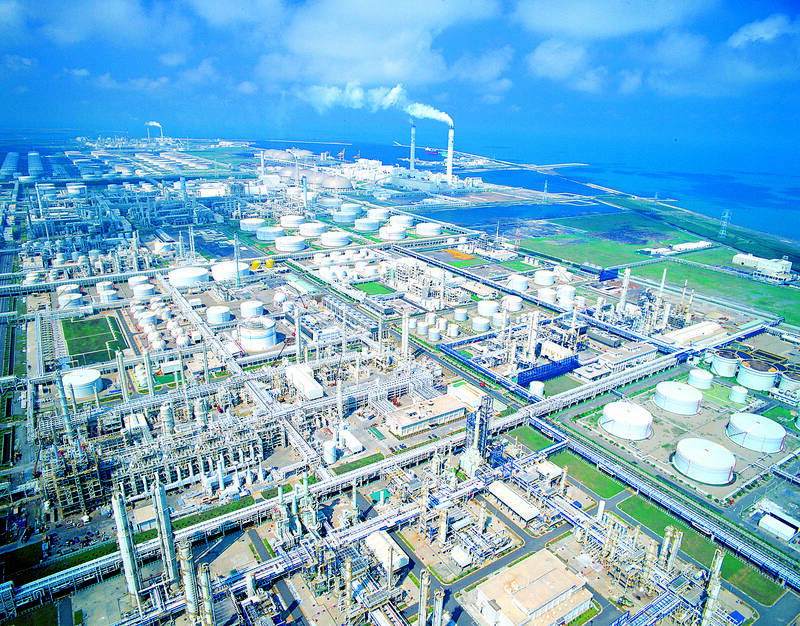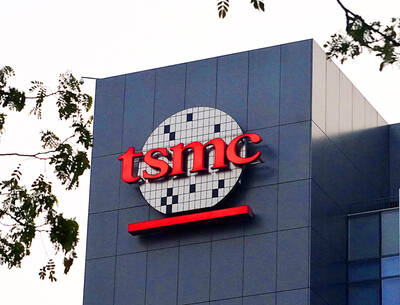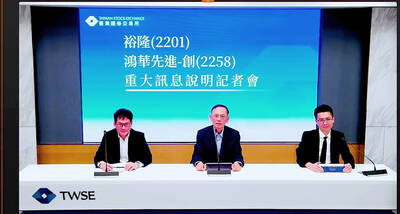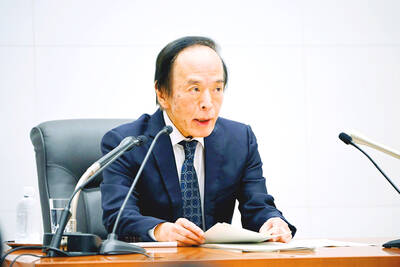Formosa Plastics Group (台塑集團), Taiwan’s largest industrial conglomerate, yesterday posted a small profit for its major four units of NT$715 million (US$21.69 million) for the fourth quarter and NT$8.37 billion for last year, it said, blaming languid demand and China’s overproduction.
The fourth-quarter results represented a comeback from losses of NT$8.03 billion in the preceding quarter, but suggested an 81 percent plunge, or earnings of NT$0.29 per share, compared with a year earlier, company data showed.
The poor earnings came even though combined revenues last year slipped only 2.1 percent to NT$1.47 trillion amid lingering excessive supply induced by Chinese peers, the group said.

Photo: Chang Huei-wen, Taipei Times
Consequently, the group said it would issue moderate year-end bonuses equivalent to three months of wages for its employees later this month.
The conglomerate said it is looking at business improvement this year for petrochemical products, but voiced concern that US president-elect Donald Trump’s planned tariff hikes would slow the pace of recovery.
Formosa Petrochemical Corp (台塑石化), engaged primarily in the business of refining crude oil, selling refined petroleum products and producing and selling olefins from its naphtha-cracking operations, last quarter emerged from losses by posting a profit of NT$1.27 billion, helped by inventory recovery, indirect investment and foreign exchange benefits, the company said in a stock exchange filing.
Similar reasons enabled the unit to book NT$5.944 billion of net income for the whole of last year, or earnings of NT$0.62 per share, it said.
Nan Ya Plastics Corp (南亞塑膠), whose main business involves producing processed plastic and chemical products, electronic materials and polyester fiber, last quarter saw its profit surge more than threefold to NT$280 million, as demand for most products picked up, it said.
Further, the company indirectly benefited from materials used in the development of artificial intelligence, it said.
For the whole of last year, Nan Ya reported a net income of NT$3.32 billion, or earnings of NT$0.42 per share, as the negative impact of global inflation and monetary tightening lessened, giving its customers renewed interest in rebuilding their inventories, it said.
However, the figures indicated a 47.4 percent retreat from a year earlier.
Formosa Chemicals and Fibre Corp (台灣化學纖維), which produces and sells petrochemical products, nylon fibers and rayon staple fibers in Taiwan and abroad, booked losses of NT$1.07 billion for the fourth quarter of last year, dragged by the falling international oil price and a supply glut, it said.
The subsidiary managed a tiny profit of NT$379 million for last year, or earnings of NT$0.06 per share, it said.
The company said it would seek to diversify its markets beyond China and focus on products that generate higher margins.
Formosa Plastics Corp (台灣塑膠), a vertically integrated supplier of plastic resins and petrochemicals, climbed out of the woods in the foruth quarter with a net income of NT$234 million, but swung to a loss of NT$1.27 billion, or NT$0.2 per share, last year, its filing said.
Core businesses continued to take losses and an investment in Fxuin Special Steel Co (福欣特殊鋼), a Chinese company based in China’s Fujian Province, also proved ill-fated, muting an increase in overall sales, it said.

Taiwan’s long-term economic competitiveness will hinge not only on national champions like Taiwan Semiconductor Manufacturing Co. (TSMC, 台積電) but also on the widespread adoption of artificial intelligence (AI) and other emerging technologies, a US-based scholar has said. At a lecture in Taipei on Tuesday, Jeffrey Ding, assistant professor of political science at the George Washington University and author of "Technology and the Rise of Great Powers," argued that historical experience shows that general-purpose technologies (GPTs) — such as electricity, computers and now AI — shape long-term economic advantages through their diffusion across the broader economy. "What really matters is not who pioneers

In a high-security Shenzhen laboratory, Chinese scientists have built what Washington has spent years trying to prevent: a prototype of a machine capable of producing the cutting-edge semiconductor chips that power artificial intelligence (AI), smartphones and weapons central to Western military dominance, Reuters has learned. Completed early this year and undergoing testing, the prototype fills nearly an entire factory floor. It was built by a team of former engineers from Dutch semiconductor giant ASML who reverse-engineered the company’s extreme ultraviolet lithography (EUV) machines, according to two people with knowledge of the project. EUV machines sit at the heart of a technological Cold

TAIWAN VALUE CHAIN: Foxtron is to fully own Luxgen following the transaction and it plans to launch a new electric model, the Foxtron Bria, in Taiwan next year Yulon Motor Co (裕隆汽車) yesterday said that its board of directors approved the disposal of its electric vehicle (EV) unit, Luxgen Motor Co (納智捷汽車), to Foxtron Vehicle Technologies Co (鴻華先進) for NT$787.6 million (US$24.98 million). Foxtron, a half-half joint venture between Yulon affiliate Hua-Chuang Automobile Information Technical Center Co (華創車電) and Hon Hai Precision Industry Co (鴻海精密), expects to wrap up the deal in the first quarter of next year. Foxtron would fully own Luxgen following the transaction, including five car distributing companies, outlets and all employees. The deal is subject to the approval of the Fair Trade Commission, Foxtron said. “Foxtron will be

INFLATION CONSIDERATION: The BOJ governor said that it would ‘keep making appropriate decisions’ and would adjust depending on the economy and prices The Bank of Japan (BOJ) yesterday raised its benchmark interest rate to the highest in 30 years and said more increases are in the pipeline if conditions allow, in a sign of growing conviction that it can attain the stable inflation target it has pursued for more than a decade. Bank of Japan Governor Kazuo Ueda’s policy board increased the rate by 0.2 percentage points to 0.75 percent, in a unanimous decision, the bank said in a statement. The central bank cited the rising likelihood of its economic outlook being realized. The rate change was expected by all 50 economists surveyed by Bloomberg. The